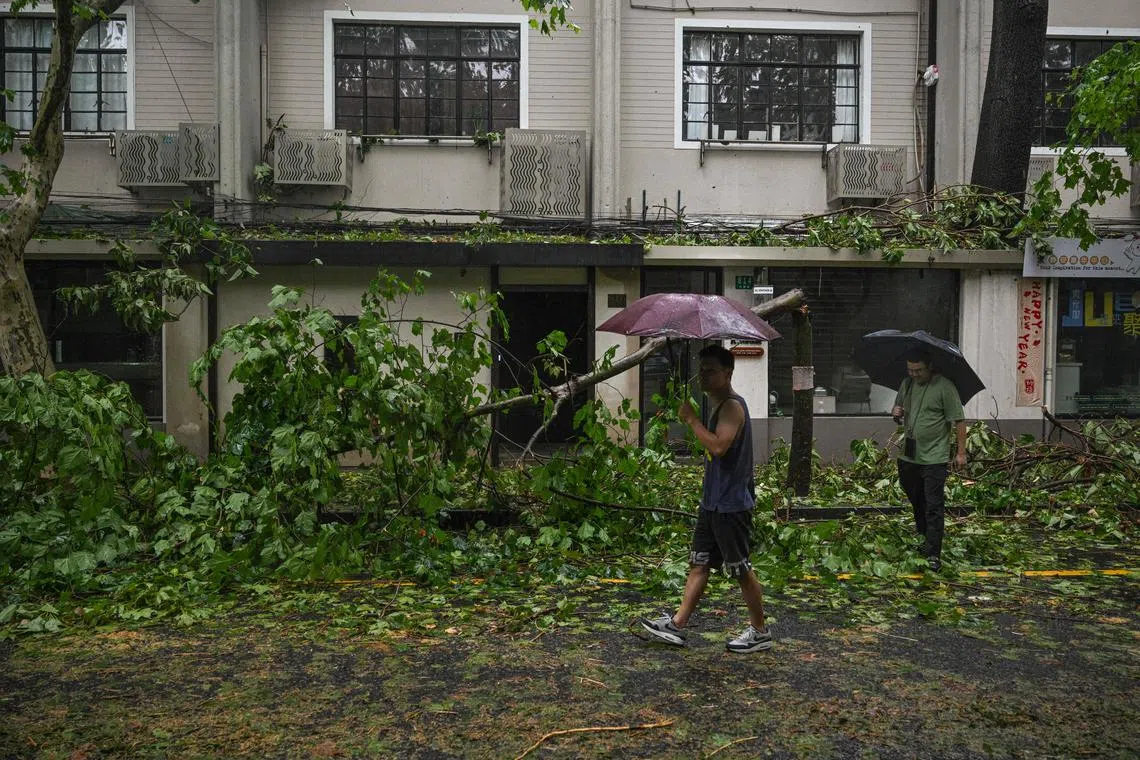Strongest typhoon to hit Shanghai since 1949 shuts down megacity
Sign up now: Get ST's newsletters delivered to your inbox
Follow topic:
BEIJING - Tens of millions of people in Shanghai and across China’s densely populated east coast hunkered indoors on Sept 16, as the strongest typhoon to hit since 1949 swept in, downing trees and disrupting transport across the region.
Typhoon Bebinca – the fiercest storm to hit the megacity since Typhoon Gloria 75 years ago – landed early in the morning of Sept 16
The municipal news service said the typhoon caused “significant damage across the city”, felling more than 1,800 trees and leaving 30,000 households without electricity.
It said 414,000 people were evacuated to safer locations, and tens of thousands of emergency personnel were on hand to be deployed when necessary.
Some 1,400 flights from Shanghai’s two airports and more than 570 passenger trains had been cancelled since Sept 15, disrupting the travel plans of millions on the move during the Mid-Autumn Festival, a three-day public holiday in China.
Some flights from Shanghai to Singapore on Sept 16 were also affected. Ms Diana Tan, CTC Travel’s head of human resources and public relations, told The Straits Times that her agency has arranged for an additional night’s stay in Shanghai for about 50 travellers, as their return date has been postponed to Sept 17.
She added that several tour groups scheduled to visit Shanghai in the next few days have also had their flights rebooked, and the agency is monitoring the situation and making adjustments to the itineraries when needed.
Meanwhile, resorts in Shanghai, including Shanghai Disney Resort, Jinjiang Amusement Park and Shanghai Wild Animal Park, have been temporarily closed and many ferry services halted.
Many businesses were already closed for the Mid-Autumn Festival public holiday, and the city’s 25 million residents have been advised to avoid leaving their homes.
Dr Xiong Zhuowu, a doctor and resident of the northern Baoshan district, posted a video of a real estate agent’s sign being ripped away onto a roof in his compound.
“I feel quite nervous today. I’m constantly checking what the situation is out the window,” Dr Xiong said.
“The property management found some trees with loose roots downstairs and immediately called me to move my car to prevent the tree hitting it if it fell.”
A government livefeed from Baoshan showed ferocious winds ripping through a line of trees on the riverbank.
At rush hour, live video feeds showed Shanghai’s normally jammed roads almost empty of traffic, and its famed skyline obscured by thick fog.
State broadcaster CCTV aired footage of a reporter by the coast in neighbouring Zhejiang province, where waves pounded the craggy coastline under leaden skies.
“If I step out (into the storm), I can barely speak,” the reporter said.
“You can see that the surface of the sea is just wave after wave, each higher than the last.”

Tree branches and leaves brought down by Typhoon Bebinca in Shanghai on Sept 16.
PHOTO: AFP
Despite the violent downpours and sudden gusts of wind, some people were still braving the weather to go about on their errands.
Ms Wu Yun said she ventured outside because she had to sort something out at her sales job.
“I think it’s okay because I also saw a lot of typhoons in the south, so I think Shanghai is okay (compared with them),” she said, even as she struggled to open her umbrella against the wind.
By the early afternoon of Sept 16, the eye of the storm had crossed from Shanghai to the neighbouring Jiangsu province, though downpours were expected to continue in China’s financial capital throughout the rest of the day.
Shanghai is rarely subject to direct hits from strong typhoons that generally make landfall farther south in China. Typhoon Yagi, a destructive Category 4 storm, roared past southern Hainan province last week.
Only one injury had been reported so far, the municipal news service said.
Workers in orange jumpsuits cleared a big pile of corrugated iron and other metal that appeared to have fallen from a nearby building onto a major road in the city centre.
Shanghai resident Tracy Huang, who ventured outside to buy supplies, watched them as the rain continued to pour.
“I didn’t plan to go out today but there was a power outage in our house,” she said.
“I don’t know (when the electricity will come back on), but it might be tonight... The community staff said it was being repaired,” Ms Huang added.

Packing top wind speeds of 151kmh near its eye, the typhoon landed in the city of nearly 25 million around 7.30am on Sept 16.
PHOTO: EPA-EFE
Meanwhile, Beijing’s Emergency Management Ministry said on Sept 14 that the storm would cause “heavy to torrential” downpours, with “local heavy or extremely heavy rainstorms” between Sept 15 and 17.
Officials held a meeting on Sept 14 to “research and deploy flood and typhoon control work in key areas”, it said.
Shanghai was last threatened by a direct hit in 2022 by the powerful Typhoon Muifa, which instead landed 300km away in the city of Zhoushan, in Zhejiang province. REUTERS, AFP
Additional reporting by Sarah Koh

